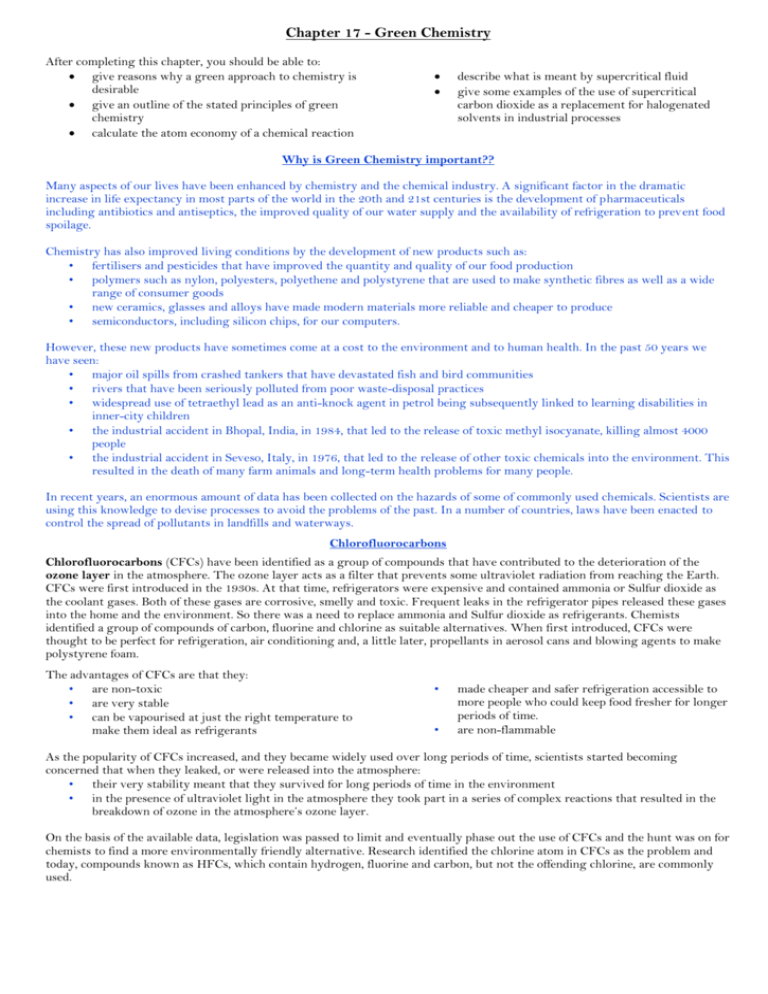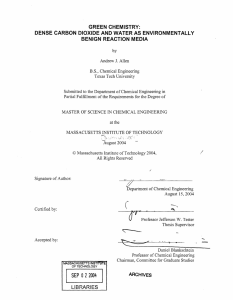Green Chemistry
advertisement

Chapter 17 - Green Chemistry After completing this chapter, you should be able to: give reasons why a green approach to chemistry is desirable give an outline of the stated principles of green chemistry calculate the atom economy of a chemical reaction describe what is meant by supercritical fluid give some examples of the use of supercritical carbon dioxide as a replacement for halogenated solvents in industrial processes Why is Green Chemistry important?? Many aspects of our lives have been enhanced by chemistry and the chemical industry. A significant factor in the dramatic increase in life expectancy in most parts of the world in the 20th and 21st centuries is the development of pharmaceuticals including antibiotics and antiseptics, the improved quality of our water supply and the availability of refrigeration to prevent food spoilage. Chemistry has also improved living conditions by the development of new products such as: • fertilisers and pesticides that have improved the quantity and quality of our food production • polymers such as nylon, polyesters, polyethene and polystyrene that are used to make synthetic fibres as well as a wide range of consumer goods • new ceramics, glasses and alloys have made modern materials more reliable and cheaper to produce • semiconductors, including silicon chips, for our computers. However, these new products have sometimes come at a cost to the environment and to human health. In the past 50 years we have seen: • major oil spills from crashed tankers that have devastated fish and bird communities • rivers that have been seriously polluted from poor waste-disposal practices • widespread use of tetraethyl lead as an anti-knock agent in petrol being subsequently linked to learning disabilities in inner-city children • the industrial accident in Bhopal, India, in 1984, that led to the release of toxic methyl isocyanate, killing almost 4000 people • the industrial accident in Seveso, Italy, in 1976, that led to the release of other toxic chemicals into the environment. This resulted in the death of many farm animals and long-term health problems for many people. In recent years, an enormous amount of data has been collected on the hazards of some of commonly used chemicals. Scientists are using this knowledge to devise processes to avoid the problems of the past. In a number of countries, laws have been enacted to control the spread of pollutants in landfills and waterways. Chlorofluorocarbons Chlorofluorocarbons (CFCs) have been identified as a group of compounds that have contributed to the deterioration of the ozone layer in the atmosphere. The ozone layer acts as a filter that prevents some ultraviolet radiation from reaching the Earth. CFCs were first introduced in the 1930s. At that time, refrigerators were expensive and contained ammonia or Sulfur dioxide as the coolant gases. Both of these gases are corrosive, smelly and toxic. Frequent leaks in the refrigerator pipes released these gases into the home and the environment. So there was a need to replace ammonia and Sulfur dioxide as refrigerants. Chemists identified a group of compounds of carbon, fluorine and chlorine as suitable alternatives. When first introduced, CFCs were thought to be perfect for refrigeration, air conditioning and, a little later, propellants in aerosol cans and blowing agents to make polystyrene foam. The advantages of CFCs are that they: • are non-toxic • are very stable • can be vapourised at just the right temperature to make them ideal as refrigerants • • made cheaper and safer refrigeration accessible to more people who could keep food fresher for longer periods of time. are non-flammable As the popularity of CFCs increased, and they became widely used over long periods of time, scientists started becoming concerned that when they leaked, or were released into the atmosphere: • their very stability meant that they survived for long periods of time in the environment • in the presence of ultraviolet light in the atmosphere they took part in a series of complex reactions that resulted in the breakdown of ozone in the atmosphere’s ozone layer. On the basis of the available data, legislation was passed to limit and eventually phase out the use of CFCs and the hunt was on for chemists to find a more environmentally friendly alternative. Research identified the chlorine atom in CFCs as the problem and today, compounds known as HFCs, which contain hydrogen, fluorine and carbon, but not the offending chlorine, are commonly used. How does green chemistry help? The laws and treaties that were enacted to reduce global pollution were often aimed at dealing with wastes after they had been generated and did not address methods to reduce the production of waste. Green chemistry, or environmentally safe chemistry, outlines a set of principles that forms a framework that can be used to evaluate the environmental impact of a chemical process. It focuses on methods that reduce or eliminate hazardous waste. The green approach is that the best way to minimise waste is not to produce it in the first place. Its ultimate goal is to implement energyefficient, hazard-free, waste-free, efficient chemical processes without sacrificing their effectiveness. Ideally: • goods needed by society should be produced by methods that are not harmful to the environment • fossil fuels, and other non-renewable resources, should be replaced by renewable ones • goods produced by society, should either be recyclable or biodegradable The processes used to manufacture the product should either produce no wastes or wastes that are recyclable or biodegradable. Green chemistry practices have major long-term cost benefits to businesses and the reduction of long-term damage to the environment. By switching to renewable energy sources, biomaterials and manufacturing chemicals that degrade into benign substances, green chemistry is protecting the planet from long-term deterioration. Industry can benefit too from green chemistry considerations, since greater efficiency leads to reduced costs and improved profits. The atom economy approach is a method of accounting for the use of materials in a manufacturing process. It tracks all the atoms in a reaction and calculates the mass of the atoms of reactants actually used to form products as a percentage of the total mass of reactants. From this, the mass of reactant atoms that end up as waste can be calculated. Supercritical carbon dioxide (scCO2) Materials commonly exist in one of three states of matter—solid, liquid or gas. When liquids are heated, they tend to form a vapour. When vapours are compressed, they tend to condense into liquid. However, if a vapour is heated above a certain critical temperature, the vapour cannot be liquefied no matter what pressure is applied. At these relatively high temperatures and pressures, the distinction between the liquid and gaseous states blur. The material has properties similar to those of gases in that it expands to fill any available space. At the same time, however, it has properties similar to those of liquids and can be used as a solvent. At this stage, the material is a supercritical fluid. Carbon dioxide forms a supercritical fluid at a pressure of about 73 atm and a temperature of about 31°C. This relatively low critical temperature makes supercritical carbon dioxide easy to work with. Another useful feature is that its solvent properties can be altered by making slight adjustments to temperature and pressure. Replacement of halogenated solvents with scCO2 - A commonly used solvent in the dry-cleaning industry is tetrachloroethene (C2Cl4) or ‘perc’. This solvent, like many other halogenated hydrocarbons, is volatile and a suspected carcinogen. Even at low concentrations, perc has unpleasant side effects to humans and used perc must be disposed of as a hazardous waste. Some dry-cleaners have now replaced this halogenated hydrocarbon with scCO2 mixed with small quantities of detergent. scCO2 is also being successfully used for various kinds of industrial cleaning. The use of scCO2 is a particularly environmentally friendly solution as it can be obtained as a by-product from other industries. It is also relatively easy to recapture and reuse and does not have the problems of toxicity associated with halogenated solvents. Chapter 17 – Q1, 2, 3, 4, 5, Pg 311 -312 Q 18, 19, 24







